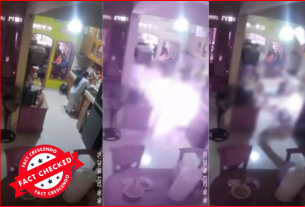A recent circulating message warns against using mobile phone flashlights near electrical circuit boards, circuit breakers, high-voltage equipment, fuel tanks, or gas tanks, claiming it may cause an explosion.
We discovered messages circulating on LINE and Facebook platforms warning translated as: “Do not use mobile phone flashlights to illuminate circuit breakers, high-voltage cutouts, fuel tanks, or gas tanks, as it may cause an explosion.”
This claim was spreading in both Thai and English contexts.
Our investigation revealed that this circulating message could lead to misunderstandings and unnecessary alarm. Therefore, we decided to thoroughly examine the validity of this information.
How do mobile phone flashlights work?
Modern mobile phone flashlights utilize LED technology, which generates light without producing significant heat or sparks. LEDs function through a process that employs low electrical current to emit light, rendering mobile phone flashlights safer than traditional light sources like incandescent bulbs, which can generate considerable heat.
Key factors for an explosion An explosion requires two essential elements:
- A flammable substance (e.g., fuel vapors or combustible gases)
- An ignition source (e.g., sparks or sufficient heat)
LED flashlights on mobile phones cannot create an ignition source on their own. However, other components of the phone, particularly the battery, may pose a risk if damaged or malfunctioning. In such cases, they could potentially generate heat or sparks. It’s important to note that these incidents are extremely rare under normal usage conditions.
Expert Comment: Furthermore, Dr. Supun Tiptipakorn, a lecturer in the Department of Electrical Engineering at Mahidol University, has debunked the claim that using a mobile phone flashlight to illuminate a circuit breaker can cause an explosion. He explains that household electrical cabinets use low-voltage electricity, making such an occurrence impossible. However, he cautions that if there’s an electrical leak and a metal phone comes into contact with it, an electric shock could occur—regardless of whether the flashlight is on or off. Regarding fuel and gas tanks, Dr. Tiptipakorn clarifies that mobile phone flashlights don’t ignite them. The real danger lies in a damaged phone potentially causing a spark near a fuel leak, which aligns with standard flammable material risks and is unrelated to the f lashlight feature. (Source)
Historical incident reports: There’s no evidence confirming that mobile phone flashlights directly cause explosions. Myths about mobile phones causing fires—for instance, at gas stations—have been debunked multiple times (see this example). The actual culprit in such cases is more likely static electricity, not flashlight use as claimed. That said, phones can potentially contribute to explosions due to battery malfunctions, though these incidents are exceedingly rare.
ALSO READ: Claim about Mobile Phones Causing Gas Stove Explosions is Misleading
Safety standards and recommendations: Organizations like OSHA and NFPA in the US advocate for “intrinsically safe” equipment in hazardous areas. These devices are engineered to prevent sparks or excessive heat. While LED flashlights don’t pose a spark risk, most mobile phones lack certification for use in environments with high concentrations of flammable substances, such as near fuel or gas tanks.
Conclusion
The claim that mobile phone flashlights can cause explosions in areas with flammable substances is an exaggeration. Nevertheless, we shouldn’t dismiss the potential risks associated with mobile phones, particularly in environments with high concentrations of flammable vapors. While a phone’s flashlight feature is safe, a malfunctioning battery or short-circuiting phone could pose a genuine hazard.





